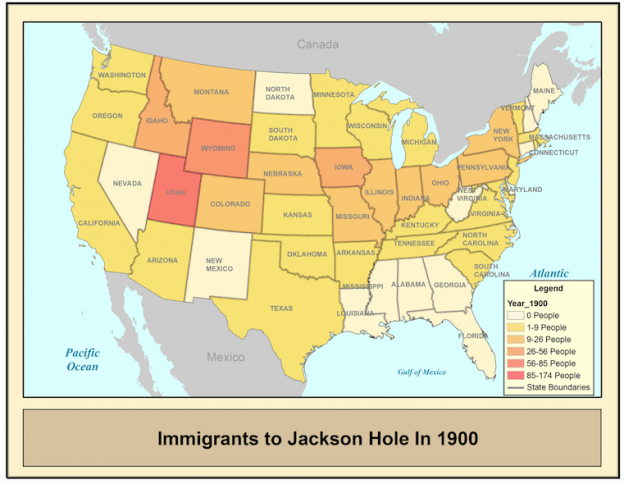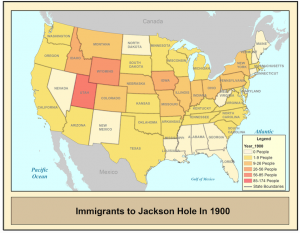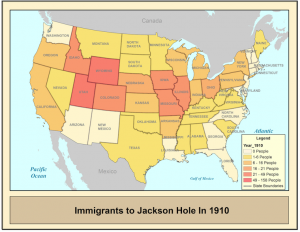USING PRIMARY SOURCE DATA TO COLOR YOUR STORY
In Jackson Hole, the Census records help to paint a complete picture of the different stages of settlement; from the needs of a small self-sustainable pioneer community to that of a thriving tourist-based economy. What are the needs of an early homesteading family and how were they addressed? How was the community growth altered when tourists began to outnumber the locals in the summers? Did this affect the landscape in the valley? All of these answers can be collected by studying the Census.
In the earliest Census snapshot of Jackson Hole, in 1900, the closest rail lines were those of the Union Pacific, and the closest stops were in Kemmerer, WY, Victor, ID and St. Anthony, ID. From there, settlers would rely on man and horsepower to make the remainder of the trip through mountain passes and rugged territory. The 1900 map of birthplaces, the states with the highest numbers are also the states where the main rail lines traveled through the country. Those who had the easiest access to transportation took advantage of it, able to cross thousands of miles in mere days. Prior to this, families making the trek west utilized handcarts or covered wagons and traveled in large groups. Jackson Hole saw few of these families, being a tiny and relatively inaccessible mountain valley. The first homesteaders to settle permanently in Jackson Hole didn’t arrive until 1884, despite the railroad being a viable travel corridor since the 1850s.
This early community had around 651 people residing in the valley. Most were listed as farmers, focusing more on growing crops of wheat, barley, alfalfa and corn for small herds of cattle. Those professions who served the community are represented in the Census: blacksmiths, carpenters, a plasterer, a butcher, a doctor, mail carrier, taxidermist, retail merchants, and schoolteachers. These were the individuals who supported their neighbors in the vital tasks of medicine, food, household supplies, building and maintaining their houses, horses and agricultural infrastructure. In the 1890s, a few families who were the first to move to Jackson Hole left the valley in search of better education for their children. In 1900, there were 10 schoolteachers listed. This speaks to the fractured settlement throughout the valley, with 10 different schools so that children didn’t have to travel too far.
Just a decade later, the population was relatively stable at 692 people. But as the town of Jackson grew and began to establish itself as a population center, the types of occupations start to diversify. Bakers, bankers, barbers, a dentist, pharmacist and a tailor all appear. These were activities normally carried out at the homestead that are now being provided for those who lived on smaller parcels, and worked the land less. Bankers were necessary because cash became a necessity to purchase goods at the mercantile, to pay the dentist and the barber, or the baker and the pharmacist. In 1900, Pap Deloney ran the only general store in the valley and he often allowed his customers to write I.O.U.s in lieu of payment until they could bring their cattle to market. Even then, outstanding notes were often lost, or forgiven. In 1910, with more services on offer in the town, the old form of banking was becoming increasingly difficult to sustain the community.

Created by Rebecca Sgouros, Director of Education and Outreach
For the first time, public lands were represented in the Jackson Hole Census in 1910. It was now desirable, and or sustainable to rely on the Forest Service as a source of income. Most individuals listed their primary occupation on the Census. Many held multiple jobs, but the one they identified with most was the one written down. These were men who also had their own homesteads, or worked as day laborers for neighbors, but chose to be represented as trappers, forest rangers, or even a surveyor. There appears to be the beginnings of the recognition that the natural resources in the valley are being relied on beyond their usefulness for the early self-sustaining pioneers. They are now part of the local economy, for better or worse.
Hospitality is another category that jumps onto the scene in 1910, with cooks, hotelkeepers, a laundress and waitress appearing on the record. Visitors are no longer housed in an extra room in someone’s home, but the earliest tourist accommodations are being constructed and staffed. These are individuals who might also require the services of bakers, or barbers.
The first dude ranch in Jackson Hole opened at the JY in 1908, with the Bar BC and White Grass following in 1912 and 1913 respectively. These three dude ranches would be responsible for the dude ranching boom in Jackson Hole, and no less than 25 additional ranches would appear on the landscape, built by former dudes and wranglers of the original three. The 1920s would become known as the golden age of dude ranches in Jackson Hole, before the 1929 Depression, and World War II changed how families went on vacation in the United States.
As a direct result of this boom, the population in the valley grew to 1,347 people. Caretakers, hotel management, engineers, game wardens, hardware stores, telephone and electricians were officially in town. The majority of the valley would not see full electrification until the late 1940s, but the party telephone line was strung throughout the valley. For the first time, the entire valley was within a moment’s communication with their neighbors. The doctor could be summoned from town within minutes, rather than waiting for a rider to make most of the day’s ride into town from the more remote reaches.
In the 1930s, the Town Square was formally fenced off, and trees planted to make it George Washington Memorial Park. The elk antler arches were added in the 1950s and 1960s, and the town of Jackson as we know it began to take shape.
ABOUT THE CENSUS
All of the above information was collected using the United States Census of 1900, 1910 and 1920. Had it been available, the 1890 Census would have been included but the majority of the documents burned in a fire in 1921. The data collected in a Census was a means to track the growth of the country. This information was used to predict future needs and to plan for sustainable town/city and territory growth. The first Census was conducted in 1790, and the most recent in 2010. The Census of 1850 included the first detailed account of social issues, city infrastructure, industrial and agricultural growth. This same year, all members of a household were listed with name, age, race, education, birthplace and occupation.
The detailed information recorded in the Census from 1850 forward creates a staggering historical record from which to draw nearly complete stories of family, community, and land use. The Census allows us to create a near-complete biography of an individual, their family and their community. Whether or not someone immigrated to the United States, learned English as their second language, the kind of job they held in a certain location, their income level (if they owned or rented their house). In some areas, the address listed on the Census is searchable on Google Maps, and sometimes the house is still standing.
Primary sources allow us to peer into the past and to understand it as our ancestors wrote it themselves. They are our most valuable records, from which endless amounts of data and information can be drawn to color in a full picture of what life was like for our great-great grandparents. Where they were born, how far they traveled (if at all) in their lives, and their roles in their communities. There are many similarities to be found through these resources that relate to us today, especially as we participate in our own upcoming Census in 2020.
Text by Samantha Ford, Research Historian






